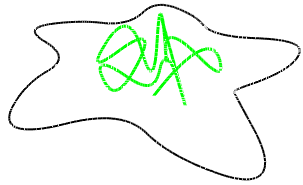Splines.
Let's create two splines.
The first spline won't be flat and closed. Its knots will lye on circles with different radii which Z coordinates will be 1 and -1 one after another.
The color of the first spline will be number 10 from the palette, line thickness will be 2:
SG_SPLINE* splGeo_1 = SG_SPLINE::Create();
SG_POINT tmpPnt;
int fl=0;
for (double i=0.0;i<2.0*3.14159265;i+=0.4)
{
tmpPnt.x = ((double)(fl%3))*cos(i);
tmpPnt.y = ((double)(fl%3))*sin(i);
tmpPnt.z = (fl%2)?1.0:-1.0;
splGeo_1->AddKnot(tmpPnt,fl);
fl++;
}
sgCSpline* spl1_obj = sgCreateSpline(*splGeo_1);
spl1_obj->SetAttribute(SG_OA_COLOR,10);
spl1_obj->SetAttribute(SG_OA_LINE_THICKNESS, 2);
sgGetScene()->AttachObject(spl1_obj);
SG_SPLINE::Delete(splGeo_1);
The second spline will be flat and closed. Its knots will lye on circles with 2, 3 and 4 radii one after another.
The color of the second spline will be number 0 from the palette, line thickness will be 1:
SG_SPLINE* splGeo_2 = SG_SPLINE::Create();
fl=0;
for (double i=0.0;i<2.0*3.14159265;i+=0.4)
{
tmpPnt.x = ((double)(fl%3+2))*cos(i);
tmpPnt.y = ((double)(fl%3+2))*sin(i);
tmpPnt.z = 0.0;
splGeo_2->AddKnot(tmpPnt,fl);
fl++;
}
splGeo_2->Close();
sgCSpline* spl2_obj = sgCreateSpline(*splGeo_2);
spl2_obj->SetAttribute(SG_OA_COLOR,0);
spl2_obj->SetAttribute(SG_OA_LINE_THICKNESS, 1);
sgGetScene()->AttachObject(spl2_obj);
SG_SPLINE::Delete(splGeo_2);
See also:
sgCSpline sgCSpline::Create SG_SPLINE sgGetScene sgCScene::AttachObject sgCObject::SetAttribute
Illustration:
